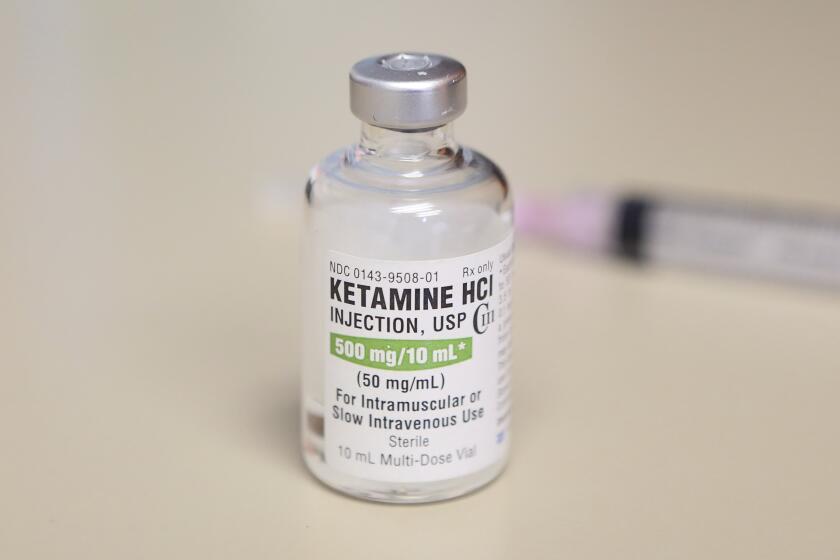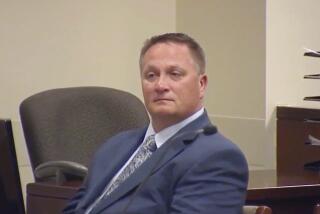Police blame some deaths on ‘excited delirium,’ but ER doctors may disavow the term

- Share via
The way Sheldon Haleck’s parents see it, the 38-year-old’s only crime was jaywalking. But that March night in 2015, after Honolulu police found him behaving erratically, they pepper-sprayed him, shocked him with a Taser and restrained him.
Haleck became unresponsive and was taken to a hospital. Before his parents could get from their home in Utah to Hawaii, the former Hawaii Air National Guardsman was taken off life support.
“Nobody’s supposed to die from something like this,” said Haleck’s father, William.
An initial autopsy ruled Haleck’s death a homicide, and his family filed a civil lawsuit in federal court against the three officers who tried to remove him from the street. The case should have been “one of the easiest wrongful-death cases” to win, said Eric Seitz, an attorney who represented Haleck’s family.
But the officers’ attorneys seized on a largely discredited, four-decade-old diagnostic theory called “excited delirium,” which has been increasingly used over the last 15 years as a legal defense to explain how a person experiencing severe agitation can die suddenly through no fault of the police.
“The entire use of that particular theory, I think, is what convinced the jury,” Seitz said.
The controversial condition is increasingly blamed when someone dies in police custody or in other stressful situations. Rights groups call it a scapegoat.
Haleck’s case is just one legal battle in which the theory of excited delirium exonerated law enforcement despite mounting opposition to the term among most prominent medical groups. The theory has been cited as a defense in the 2020 deaths of George Floyd in Minneapolis; Daniel Prude in Rochester, N.Y.; and Angelo Quinto in Antioch, Calif. It also figures in a criminal trial against two police officers involved in the 2019 death of Elijah McClain in Aurora, Colo., now underway.
It has allowed defense attorneys to argue that individuals in police custody died not of restraint, not of a Taser shock, but of a medical condition that can lead to sudden death.
But now, the American College of Emergency Physicians will vote at an October meeting on whether to formally disavow its 2009 position paper supporting excited delirium as a diagnosis that helped undergird those court cases. The draft resolution also calls on ACEP to discourage physicians who serve as expert witnesses from promoting the theory in criminal and civil trials.
“It’s junk science,” said Dr. Martin Chenevert, an emergency medicine physician at UCLA Santa Monica Medical Center, who often testifies as an expert witness. The theory has been used to provide a cover for police misconduct, he said. “It had an agenda.”
Passing the resolution wouldn’t bring Haleck back, but his parents hope it would prevent other families from experiencing their agony. “May that excited delirium die here,” said his mother, Verdell.

Gov. Gavin Newsom is considering signing into law a bill passed last month that would do much the same in California.
“If we don’t fully denounce this now, it will be there for the grasping, again,” said Dr. Jennifer Brody, a physician with the Boston Health Care for the Homeless Program, who co-wrote a 2021 opinion piece calling on organized medicine to denounce excited delirium. “Historically, we know what happens: The pendulum swings the other way.”
Most major medical societies, including the American Medical Assn. and the American Psychiatric Assn., don’t recognize excited delirium as a medical condition. This year, the National Assn. of Medical Examiners rejected excited delirium as a cause of death.
No blood test or other diagnostic test can confirm the syndrome. It’s not listed in the Diagnostic and Statistical Manual of Mental Disorders, a reference book of mental health conditions, nor does it have its own diagnostic code, a system used by health professionals to identify diseases and disorders.
But its pervasiveness in excessive-use-of-force cases has persisted in large part because of the American College of Emergency Physicians’ 2009 white paper proposing that individuals in a mental health crisis, often under the influence of drugs or alcohol, can exhibit superhuman strength as police try to control them, and then die from the condition.
The drug ketamine, which is sometimes injected as a sedative during arrests, has drawn new scrutiny since a young Black man died in suburban Denver.
The ACEP white paper has been cited in cases across the U.S., and lawyers who file police misconduct cases said that courts and judges accept the science without sufficient scrutiny.
ACEP’s position “has done a lot of harm” by justifying first-responder tactics that contribute to a person’s death, said Joanna Naples-Mitchell, an attorney who worked on a Physicians for Human Rights review of excited delirium. The term has also been used in cases in Australia, the United Kingdom, Canada and other countries, according to the group.
“This is a really important opportunity for ACEP to make things right,” she said of the upcoming vote.
ACEP officials declined requests for an interview.
Starting in the mid-1990s, the leading proponents of excited delirium produced research with funding from Taser International, a maker of stun guns used by police, which later changed its name to Axon. The research purported to show that the technique of prone restraint, in which suspects are lying face down on the ground with the police officer’s weight on top of them, and Taser shocks couldn’t kill someone.
That research formed the basis of the white paper, providing an alternative cause of death that defense attorneys could argue in court. Many emergency physicians say the ACEP document never lived up to the group’s standard for clinical guidelines.
Axon officials did not respond to a call or email seeking comment on the white paper or the upcoming ACEP vote. In 2017, Taser officials used the ACEP position on excited delirium as evidence that it is a “universally recognized condition,” according to Reuters.
A recent review published in the journal Forensic Science, Medicine and Pathology concluded that no scientific evidence exists for the diagnosis, and that the authors of the 2009 white paper engaged in circular reasoning and faulty logic.
“Excited delirium is a proxy for prone-related restraint when there is a death,” said Michael Freeman, an associate professor of forensic medicine at Maastricht University in the Netherlands, who co-wrote the review. “You don’t find that people get ‘excited delirium’ if they haven’t also been restrained.”

Between 2009 and 2019, Florida medical examiners attributed 85 deaths to excited delirium, and at least 62% involved the use of force by law enforcement, according to a January 2020 report in Florida Today. Black and Latino people accounted for 56% of 166 deaths in police custody attributed to excited delirium from 2010 to 2020, according to a December 2021 Virginia Law Review article.
This year, ACEP issued a formal statement saying the group no longer recognizes the term “excited delirium,” along with new guidance to doctors on how to treat individuals presenting with delirium and agitation in what it now calls “hyperactive delirium syndrome.”
But the group stopped short of retracting the 2009 white paper. For the last 14 years, ACEP took no steps to withdraw the document or to discourage defense attorneys from using it in court.
Even now, lawyers say, they must continually debunk the theory.
“Excited delirium has continued to come up in every single restraint asphyxia case that my partner and I have handled,” said Julia Sherwin, a civil rights attorney in Oakland. “Instead of acknowledging that the person died from the police tactics, they want to point to this alternate theory of deaths.”
Now, plaintiffs’ attorneys say, if ACEP passes the resolution it would be the most meaningful step yet toward keeping the theory out of the courtroom. The resolution calls on ACEP to “clarify its position in writing that the 2009 white paper is inaccurate and outdated,” and to withdraw approval for it.
On an April night in 1989, Jo Ann Parks survived a house fire in the Southern California city of Bell that claimed the lives of her three small children.
Despite the theory’s lack of scientific underpinning, backers of the ACEP resolution expect heated debate before the vote scheduled this weekend. Emergency physicians often encounter patients with agitation and delirium, they say, and are sympathetic to other first responders who share the challenge of managing such patients. While they have tools such as sedation to help them in the emergency room, law enforcement officials must often subdue potentially dangerous individuals without such help.
Most people won’t die as a result of police tactics such as prone restraint or Taser use, but a small fraction do.
“It’s a crappy, crappy situation, when you have someone who’s out of control, who can’t make decisions for himself, and is potentially a threat somewhere,” said Dr. Jared Strote, an emergency medicine professor at the University of Washington. “It’s not like they have a sticker on their head that says, ‘Hey, I’m at high risk. If you hold me down, then I could go into sudden cardiac arrest.’”
Nonetheless, sentiment is growing among emergency physicians that the 2009 ACEP white paper has resulted in real harm and injustices, and it’s time to set it aside.
“We’ll be able to close the chapter on it and move forward to recognize explicitly that this was in error,” said Dr. Brooks Walsh, an emergency physician from Bridgeport, Conn., and a key player in bringing the resolution up for a vote. “We definitely have an ethical responsibility to address mistakes or evolutions in medical thinking.”
Chris Vanderveen, KUSA-TV’s director of special projects, contributed to this report. This article was produced by KFF Health News, formerly known as Kaiser Health News, a national newsroom that produces in-depth journalism about health issues.








